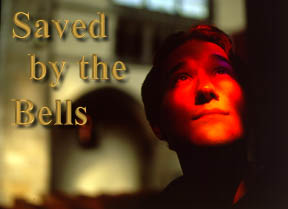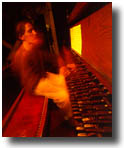 |

| by Kimberly Sweet |
| Photagraphy by Dan Dry |
|
One day in
1994, Sean Duffy, '99, was running his hands up and down the keyboard
of his Yamaha upright, playing Franz Liszt's Hungarian Rhapsody
no. 2 and Transcendental Etude no. 10. The next day the swollen
joints of his fingers would barely let him touch the piano keys.
About to enter
his senior year of high school in Philadelphia, Duffy had developed
arthritis as a result of contracting Lyme disease earlier that summer.
He'd been working at a local nursery, and some of the nursery's
plants had come from Lyme, Connecticut, where the disease was first
identified.
"I sat at the
piano and was going like this," Duffy says, pretending to play and
reenacting the ache he felt in his hands, "and I thought, 'Oh my
god, I'm never going to be able to do this again.'"
 A
pianist since the age of 12, Duffy had been considering attending
Oberlin or even Juilliard to study music and art. Instead, unable
to play for more than a few minutes at a time, Duffy decided to
explore interests in English and psychology at college. A scholarship
drew him to the U of C. When he first stepped on campus, he hadn't
played the piano for more than a year, but wanted to remain a musician.
Then he found an instrument he could play: the University's Laura
Spelman Rockefeller Memorial Carillon. With 72 bells that span six
octaves and range in weight from 10 pounds to 18 1/2 tons, the carillon
is operated via a playing console. Much like a piano's, the carillon's
playing console has foot pedals and two rows of keys. But rather
than a piano's delicate ivories, the carillon has large oak batons-and
is played with the fists. Perfect for a pianist lacking in digital
dexterity. A
pianist since the age of 12, Duffy had been considering attending
Oberlin or even Juilliard to study music and art. Instead, unable
to play for more than a few minutes at a time, Duffy decided to
explore interests in English and psychology at college. A scholarship
drew him to the U of C. When he first stepped on campus, he hadn't
played the piano for more than a year, but wanted to remain a musician.
Then he found an instrument he could play: the University's Laura
Spelman Rockefeller Memorial Carillon. With 72 bells that span six
octaves and range in weight from 10 pounds to 18 1/2 tons, the carillon
is operated via a playing console. Much like a piano's, the carillon's
playing console has foot pedals and two rows of keys. But rather
than a piano's delicate ivories, the carillon has large oak batons-and
is played with the fists. Perfect for a pianist lacking in digital
dexterity.
"I heard the
carillon, and I was like, 'I have to play it,'" Duffy recalls. "'It's
the loudest musical instrument, it's huge, and you don't need to
use your fingers.'"
Almost three
years later, Duffy, a psychology concentrator, now gives carillon
concerts every Tuesday from 6 to 6:30 p.m. His selections range
from Johann Pachelbel's Canon in D Major to "Air" from Suite III
by 20th-century Belgian composer Henk Badings to the "Muppet Show
Theme Song." He's begun to compose carillon pieces, and while his
arthritis has eased enough that he can "noodle" on the piano for
longer stretches, the carillon has become his instrument of choice.
One of about
180 carillons in North America, the U of C's carillon is the world's
second largest, topped only by the Rockefeller carillon in Manhattan.
Dedicated in 1932, the U of C's weighs more than 100 tons, about
78 tons of copper and 22 of tin. Rather than swinging, the bells
are fixed to a frame, and clappers strike their inside lips. Visitors
who wish to climb the 270 narrow steps to the top of the belltower
can take a tour before scheduled performances, given by a different
carillonneur from the community each weekday evening. University
carillonneur Wylie Crawford, MAT'70, plays after Sunday services
and during convocations and other major U of C ceremonies.
Crawford also
gives lessons on Sundays, starting students-including Duffy-off
on a practice keyboard hooked up to a xylophone in the chapel's
basement. Duffy graduated to the actual instrument after more than
a year of biweekly lessons.
"He was very
enthusiastic, very capable, very talented," says Crawford. "He's
been a great booster of the carillon as well. Being a carillonneur
is not just the musicality. People don't know what a carillon is-you
have to be a PR person, too."
To spread the
word to his fellow students, Duffy initiated in fall 1996 a pre-finals
study break in the belltower, complete with carillon music, milk,
and cookies. More recently, he founded a recognized student organization
for carillon enthusiasts named "Societas Campanariorum," or "The
Society of Bellringers."
His deeper
concern, though, is talking up the carillon's need for professional
reconditioning, which ideally should take place every 50 years,
but hasn't yet, as it's a rather expensive proposition. Pointing
out clappers with convex surfaces worn flat, as well as rusting
wires, some of which the carillonneurs have replaced with coat hangers,
Duffy says, "It's such a shame that this huge musical instrument
that is located inside this central and dominant feature of the
University, would be held together by Elmer's Glue and tape."
Duffy, who
also gives carillon tours and maintains Rockefeller Chapel's Web
site, may get his biggest audience yet this summer, when he hopes
to participate in a duet at the U of C's annual carillon festival.
The series of ten Sunday evening concerts runs from June 21 to August
23 and features performers from Illinois, Wisconsin, Texas, and
the Netherlands. But Duffy's main focus during the summer will be
working with Bert Cohler, AB'61, the William Rainey Harper professor
in the College, on a study of how disruptions affect schizophrenic
patients' narrative memory and their ability to relate their life
stories. Duffy is already looking into graduate programs in psychology,
preferably at a school with a carillon, where he can keep trying
to revive an art form on the wane. "
A lot of belltowers
aren't being played because there's no one to play them," he says.
"I really want to see people in the future playing the instrument.…It's
brought me a lot of joy."
To hear
the carillon and to learn more, visit the carillon Web page at:
http://rockefeller.uchicago.edu/music/carillon/.
|

